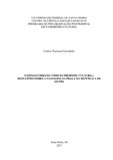| dc.creator | Cecchetto, Carise Taciane | |
| dc.date.accessioned | 2018-12-17T12:43:15Z | |
| dc.date.available | 2018-12-17T12:43:15Z | |
| dc.date.issued | 2017-12-19 | |
| dc.identifier.uri | http://repositorio.ufsm.br/handle/1/15113 | |
| dc.description.abstract | The urban square is understood as a wide and limited by streets space composed by the grouping of architectonics and vegetation elements, turned exceptionally to the public enjoy. It also integrates in the concept of synthetic landscape, that is, a previously natural building with human interference and agency, which can show the character of landscaped architectonic patrimony for being attached to historical, socials or artistic factors of a small group or, yet, of a nation. Therefore, the landscape of Praça da República is the element of exploration of these concepts in the actual research.
In this way, the study explains about Ijuí´s Praça da República as landscaped architectonic patrimony for its relevancy as historical and cultural manifestation place, for the formulation of built central landscape, for the environment and recreational attribution, as well for being the center of expansion of the urban road trace. Still, objectives primarily, to analyze the physic changes of the asset and the surroundings along the time, to verify if the central landscape has vestiges of its origin, dated back to the beginning of the colonization.
The methodological approach is defined as qualitative, with exploratory character, specifically for the results and discussion chapter, the procedures for the investigation are historic and comparative.
Lastly, through the portrayed history and the product attached to it, pretends to stimulate the patrimonial education and exalt the sentimental bounding of the community to this patrimony, making it recognize that this is of its property and makes part of its memory, depending the existence of a legacy, of the protective attitudes of each one and everyone togheter. | eng |
| dc.language | por | por |
| dc.publisher | Universidade Federal de Santa Maria | por |
| dc.rights | Attribution-NonCommercial-NoDerivatives 4.0 International | * |
| dc.rights.uri | http://creativecommons.org/licenses/by-nc-nd/4.0/ | * |
| dc.subject | Patrimônio cultural | por |
| dc.subject | Paisagem | por |
| dc.subject | Praça | por |
| dc.subject | Arquitetura paisagística | por |
| dc.subject | Cultural patrimony | eng |
| dc.subject | Landscape | eng |
| dc.subject | Landscaped architectonic | eng |
| dc.subject | Urban square | eng |
| dc.title | O espaço urbano como patrimônio cultural: reflexões sobre a paisagem da Praça da República de Ijuí/RS | por |
| dc.title.alternative | The urban space as cultural patrimony: reflections about Ijuí´s Praça da República landscape | eng |
| dc.type | Dissertação | por |
| dc.description.resumo | A praça é entendida como um espaço amplo e delimitado por ruas, composto pelo agrupamento de elementos arquitetônicos e vegetais, voltado excepcionalmente ao desfrute público. Essa também se integra no conceito de paisagem sintética, ou seja, uma construção anteriormente natural com interferência e agenciamento humano, que pode apresentar caráter de patrimônio arquitetônico paisagístico por estar vinculada a fatores históricos, sociais ou artísticos de um pequeno grupo ou, ainda, de uma nação. Por conseguinte, a paisagem da Praça da República é elemento de exploração desses conceitos nessa pesquisa.
Dessa forma, o estudo explana sobre a Praça da República de Ijuí enquanto patrimônio arquitetônico paisagístico, devido a sua relevância como local de manifestações históricas e culturais, pela formulação da paisagem central edificada, pela atribuição ambiental e recreativa, bem como por ser núcleo de expansão do traçado viário urbano. Ainda, objetiva primordialmente, analisar as alterações físicas do bem e do seu entorno ao longo do tempo, a fim de verificar se a paisagem central possui vestígios de sua origem, datada do início da colonização.
A abordagem metodológica define-se como qualitativa, de caráter exploratório, sendo que especificamente para realização do capítulo de resultados e discussão, os procedimentos para investigação são histórico e comparativo.
Por fim, por meio da história retratada e do produto atrelado a ela, pretende-se estimular a educação patrimonial e engrandecer o vínculo sentimental da comunidade sobre esse patrimônio, fazendo-a reconhecer que este é de sua propriedade e que faz parte da sua memória, dependendo a existência de um legado, das atitudes protetivas de cada um e todos juntos. | por |
| dc.contributor.advisor1 | Lopes, Caryl Eduardo Jovanovich | |
| dc.contributor.advisor1Lattes | http://lattes.cnpq.br/0701827238095286 | por |
| dc.contributor.referee1 | Saad, Denise de Souza | |
| dc.contributor.referee1Lattes | http://lattes.cnpq.br/5104361169659851 | por |
| dc.contributor.referee2 | Pereira, Clarissa de Oliveira | |
| dc.contributor.referee2Lattes | http://lattes.cnpq.br/1952567883594336 | por |
| dc.creator.Lattes | http://lattes.cnpq.br/2262152722547232 | por |
| dc.publisher.country | Brasil | por |
| dc.publisher.department | História | por |
| dc.publisher.initials | UFSM | por |
| dc.publisher.program | Programa de Pós-Graduação em Patrimônio Cultural | por |
| dc.subject.cnpq | CNPQ::CIENCIAS HUMANAS::HISTORIA | por |
| dc.publisher.unidade | Centro de Ciências Sociais e Humanas | por |



